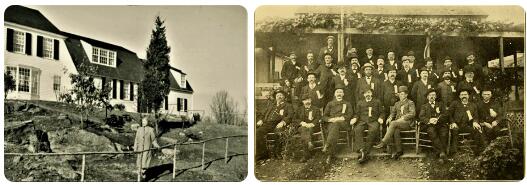Introduction
Connecticut (abbr.: CT or Conn.), state in the northeastern United States of America, 12,997 km2, with 3.3 million inhabitants; capital city: Hartford.
Physical Geography
The lower reaches of the Connecticut River (660 km long) split the state into a mountainous western and lower eastern region. Due to the many bays and coves, the coastline is relatively very long: about 900 km (about 175 km as the crow flies). Long Island protects the coast from the Atlantic storms. Due to the predominant land wind, the climate is continental rather than maritime.
Population
The state is one of the most populous in the United States (229 inhabitants per km2). About 79% of the population lives in urban areas. The largest cities are: Hartford, New Haven, Bridgeport and Waterbury. Connecticut occupies a leading position in education; there are several universities, of which Yale University (founded 1701) in New Haven is regarded as one of the best universities in the country and even the world.
Economy
Agriculture, which is of little economic importance, mainly consists of livestock (beef and poultry). The main agricultural product is tobacco; in the valleys of the Connecticut and Housatonic rivers there is fruit and vegetable cultivation. The insurance industry, centered on Hartford, plays an important role in the state’s economy. The industry is based on the formerly very flourishing cottage industry, which is still noticeable in products such as silver and pewter objects, nails, screws and clocks. However, the main industrial products today are helicopters, aircraft parts, ball bearings, weapons, electrical appliances, nuclear submarines, optical instruments and chemicals. Because Connecticut has largely preserved its rural character despite industrialization,
Sights
Connecticut has a beautiful landscape, with hills, lakes and natural areas. The many historical monuments (17th and 18th century houses, etc.) are carefully preserved by more than 100 associations operating in the state. Frequently visited is the Seaport and Marine Museum in Mystic (ship models, etc.; several old whalers in the harbor). The total area of state forests and parks is approximately 65,000 ha.
History
The first European to arrive in Connecticut was the Dutch skipper Adriaan Block, who sailed up the Connecticut River in 1614. In 1633 the Dutch established a fort at Hartford to counter English pressure, but soon the area was inundated by the much more numerous English settlers. In 1636, Rev. Thomas Hooker arrived from Massachusetts with 110 members of his congregation; the following year, the Native American tribe of the Pequots was destroyed in a bloody war. In 1639, the Fundamental Orders of Connecticut, America’s first written constitution, were adopted. In 1662 the colony received a very democratic charter from King Charles II. Connecticut had an active part in the American Revolutionary War; it was the only state where there were virtually no Tories or royalists.
